Anthropogenic Drivers Leading to Population Decline and Genetic Preservation of the Eurasian Griffon Vulture (Gyps fulvus)
Abstract
1. Introduction
2. The Genus Gyps
3. The Eurasian Griffon Vulture: Ecology and Behaviour
3.1. Habitat
3.2. Food Availability
3.3. Reproductive Investment
4. Eurasian Griffon Population Expansion and Decline
5. Conservation Strategies
6. The Eurasian Griffon Vulture: Phylogeny and Genetic Diversity
6.1. Mitochondrial DNA
6.2. Microsatellite Markers
7. Conclusions
Author Contributions
Funding
Institutional Review Board Statement
Informed Consent Statement
Conflicts of Interest
References
- Wilson, M.W.; Ridlon, A.D.; Gaynor, K.M.; Gaines, S.D.; Stier, A.C.; Halpern, B.S. Ecological impacts of human-induced animal behaviour change. Ecol. Lett. 2020, 23, 1522–1536. [Google Scholar] [CrossRef]
- Díaz, S.; Settele, J.; Brondízio, E.S.; Ngo, H.T.; Agard, J.; Arneth, A.; Balvanera, P.; Brauman, K.A.; Butchart, S.H.M.; Chan, K.M.A.; et al. Pervasive human-driven decline of life on Earth points to the need for transformative change. Science 2019, 366, eaax3100. [Google Scholar] [CrossRef] [PubMed]
- Leclère, D.; Obersteiner, M.; Barrett, M.; Butchart, S.H.M.; Chaudhary, A.; De Palma, A.; DeClerck, F.A.J.; Di Marco, M.; Doelman, J.C.; Dürauer, M.; et al. Bending the curve of terrestrial biodiversity needs an integrated strategy. Nature 2020, 585, 551–556. [Google Scholar] [CrossRef] [PubMed]
- Maxwell, S.; Fuller, R.; Brooks, T.; Watson, J. The ravages of guns, nets and bulldozers. Nature 2016, 536, 143–145. [Google Scholar] [CrossRef] [PubMed]
- Tollefson, J. Humans are driving one million species to extinction. Nature 2019, 569, 171. [Google Scholar] [CrossRef]
- García-Jiménez, R.; Morales-Reyes, Z.; Pérez-García, J.M.; Margalida, A. Economic valuation of non-material contributions to people provided by avian scavengers: Harmonizing conservation and wildlife-based tourism. Ecol. Econ. 2021, 187, 107088. [Google Scholar] [CrossRef]
- DeVault, T.L.; Beasley, J.C.; Olson, Z.H.; Moleón, M.; Carrete, M.; Margalida, A.; Sanchez-Zapata, J.A. Ecosystem Services Provided by Avian Scavengers. In Why Birds Matter; Sekercioglu, Ç.H., Wenny, D.G., Whelan, C.J., Eds.; Univ. Chicago Press: Chicago, IL, USA, 2016; pp. 235–270. [Google Scholar]
- Oro, D.; Margalida, A.; Carrete, M.; Heredia, R.; Doná Zar, J.A. Testing the Goodness of Supplementary Feeding to Enhance Population Viability in an Endangered Vulture. PLoS ONE 2008, 3, e4084. [Google Scholar] [CrossRef]
- Oro, D.; Genovart, M.; Tavecchia, G.; Fowler, M.S.; Martinez-Abraìn, A. Ecological and evolutionary implications of food subsidies from humans. Ecol. Lett. 2013, 16, 1501–1514. [Google Scholar] [CrossRef]
- Gilbert, M.; Watson, R.T.; Ahmed, S.; Asim, M.; Johnson, J.A. Vulture restaurants and their role in reducing diclofenac exposure in Asian vultures. Bird Conserv. Int. 2007, 17, 63–77. [Google Scholar] [CrossRef]
- García-Alfonso, M.; Van Overveld, T.; Gangoso, L.; Serrano, D.; Donázar, J.A. Vultures and Livestock: The Where, When, and Why of Visits to Farms. Animals 2020, 10, 2127. [Google Scholar] [CrossRef]
- Ogada, D.L.; Keesing, F.; Virani, M.Z. Dropping dead: Causes and consequences of vulture population declines worldwide. Year Ecol. Conserv. Biol. 2012, 1249, 57–71. [Google Scholar] [CrossRef]
- Moleón, M.; Sánchez-Zapata, J.A.; Margalida, A.; Carrete, M.; Owen-Smith, N.; Donázar, J.A. Humans and scavengers: The evolution of interactions and ecosystem services. Bioscience 2014, 64, 394–403. [Google Scholar] [CrossRef]
- García-Jiménez, R.; Pérez-García, J.M.; Margalida, A. Drivers of daily movement patterns affecting an endangered vulture flight activity. BMC Ecol. 2018, 18, 1–15. [Google Scholar] [CrossRef] [PubMed]
- Seibold, I.; Helbig, A.J. Evolutionary history of New and Old World vultures inferred from nucleotide sequences of the mitochondrial cytochrome b gene. Philos. Trans. R. Soc. Lond. Ser. B Biol. Sci. 1995, 350, 163–178. [Google Scholar] [CrossRef]
- Wink, M. Phylogeny of Old and New World Vultures (Aves: Accipitridae and Cathartidae) Inferred from Nucleotide Sequences of the Mitochondrial Cytochrome b Gene. Z. Naturforsch C. J. Biosci. 1995, 50, 868–882. [Google Scholar] [CrossRef]
- Campbell, M.O. A Fascinating Example for Convergent Evolution: Endangered Vultures. J. Biodivers. Endanger. Species 2014, 2, 2–4. [Google Scholar] [CrossRef]
- Mccormack, J.E.; Harvey, M.G.; Faircloth, B.C.; Crawford, N.G.; Glenn, T.C. A Phylogeny of Birds Based on Over 1,500 Loci Collected by Target Enrichment and High-Throughput Sequencing. PLoS ONE 2013, 8, e54848. [Google Scholar] [CrossRef]
- Prum, R.O.; Berv, J.S.; Dornburg, A.; Field, D.J.; Townsend, J.P.; Moriarty Lemmon, E.; Lemmon, A.R. A comprehensive phylogeny of birds (Aves) using targeted next-generation DNA sequencing. Nature 2015, 526, 569–573. [Google Scholar] [CrossRef]
- Jarvis, E.D.; Ye, C.; Liang, S.; Yan, Z.; Zepeda, M.L.; Campos, P.F.; Missael, A.; Velazquez, V.; Samaniego, J.A.; Avila-arcos, M.; et al. A Phylogeny of Modern Birds. Science 2014, 346, 1126–1138. [Google Scholar]
- Johnson, J.A.; Brown, J.W.; Fuchs, J.; Mindell, D.P. Multi-locus phylogenetic inference among New World Vultures (Aves: Cathartidae). Mol. Phylogenet. Evol. 2016, 105, 193–199. [Google Scholar] [CrossRef]
- Moreno-Opo, R.; Trujillano, A.; Arredondo, Á.; González, L.M.; Margalida, A. Manipulating size, amount and appearance of food inputs to optimize supplementary feeding programs for European vultures. Biol. Conserv. 2015, 181, 27–35. [Google Scholar] [CrossRef]
- Moreno-Opo, R.; Trujillano, A.; Margalida, A. Behavioral coexistence and feeding efficiency drive niche partitioning in European avian scavengers. Behav. Ecol. 2016, 27, 1041–1052. [Google Scholar] [CrossRef]
- Van Overveld, T.; Blanco, G.; Moleón, M.; Margalida, A.; Sánchez-Zapata, J.A.; De La Riva, M.; Donázar, J.A. Integrating vulture social behavior into conservation practice. Condor 2020, 122, 1–20. [Google Scholar] [CrossRef]
- Moreno-Opo, R.; Trujillano, A.; Margalida, A. Larger size and older age confer competitive advantage: Dominance hierarchy within European vulture guild. Sci. Rep. 2020, 10, 2430. [Google Scholar] [CrossRef] [PubMed]
- Ruxton, G.D.; Houston, D.C. Obligate vertebrate scavengers must be large soaring fliers. J. Theor. Biol. 2004, 228, 431–436. [Google Scholar] [CrossRef] [PubMed]
- IUCN The IUCN Red List of Threatened Species. Available online: https://www.iucnredlist.org/ (accessed on 27 September 2021).
- Safford, R.; Andevski, J.; Botha, A.; Bowden, C.G.R.; Crockford, N.; Garbett, R.; Margalida, A.; Ramírez, I.; Shobrak, M.; Tavares, J.; et al. Commentary Vulture conservation: The case for urgent action. Bird Conserv. Int. 2019, 29, 1–9. [Google Scholar] [CrossRef]
- Campbell, M.O. Vultures Their Evolution, Ecology and Conservation, 1st ed.; CRC Press: Boca Raton, FL, USA, 2016; ISBN 9780367738105. [Google Scholar]
- Vrba, E.S. African Bovidae: Evolutionary events since the Miocene. S. Afr. J. Sci. 1985, 81, 263–266. [Google Scholar]
- Arctander, P.; Johansen, C.; Coutellec-Vreto, M.A. Phylogeography of three closely related African bovids (tribe Alcelaphini). Mol. Biol. Evol. 1999, 16, 1724–1739. [Google Scholar] [CrossRef]
- Hassanin, A.; Douzery, E.J.P. The Tribal Radiation of the Family Bovidae (Artiodactyla) and the Evolution of the Mitochondrial Cytochrome b Gene. Mol. Phylogenet. Evol. 1999, 13, 227–243. [Google Scholar] [CrossRef]
- Matthee, C.A.; Davis, S.K. Molecular Insights into the Evolution of the Family Bovidae: A Nuclear DNA Perspective. Mol. Biol. Evol. 2001, 18, 1220–1230. [Google Scholar] [CrossRef]
- Houston, D.C. The adaptive radiation of the griffon vultures. In Vulture Biology and Management; Wilbur, S.R., Jackson, J.A., Eds.; University of California: Berkeley, CA, USA, 1983; pp. 135–152. [Google Scholar]
- Lambertucci, S.A.; Margalida, A.; Speziale, K.L.; Amar, A.; Ballejo, F.; Bildstein, K.L.; Blanco, G.; Botha, A.J.; Bowden, C.G.; Cortés-Avizanda, A.; et al. Presumed killers? Vultures, stakeholders, misperceptions, and fake news. Conserv. Sci. Pract. 2021, 3, e415. [Google Scholar] [CrossRef]
- Margalida, A.; Campion, D.; Donazar, J.A. Vultures vs. livestock: Conservation relationships in an emerging conflict between humans and wildlife. Oryx 2014, 48, 172–716. [Google Scholar] [CrossRef]
- Margalida, A.; Donazar, J.A. Fake news and vultures. Nat. Sustain. 2020, 3, 492–493. [Google Scholar] [CrossRef]
- McCarthy, E.M. Handbook of Avian Hybrids of the World; Oxford University Press, Inc.: New York, NY, USA, 2006; Volume 120, ISBN 9780195183238. [Google Scholar]
- BirdLife International Species Factsheet: Gyps Fulvus. Available online: http://www.birdlife.org (accessed on 28 June 2021).
- del Hoyo, J.; Elliot, A.; Sargatal, J. Volume 2, New World Vultures to Guineafowl. In Handbook of the Birds of the World; del Hoyo, J., Elliott, A., Sargatal, J., Eds.; Lynx Edicions (Barcelona): Barcelona, Switzerland, 1994. [Google Scholar]
- Blue Sky Wildlife Spanish Vulture: Finding Vultures in Spain. Available online: https://www.blueskywildlife.com/spanish-vulture/ (accessed on 20 September 2021).
- Del Moral, J. The Eurasian Griffon Vulture in Spain. Breeding Population in 2008 and Census Technique; Technical Report No 30; SEO/BirdLife: Madrid, Spain, 2009. [Google Scholar]
- Del Moral, J.C.; Molina, B. El buitre leonado en España, población reproductora en 2018 y método de censo; SEO/BirdLife: Madrid, Spain, 2008; ISBN 9788494985430. [Google Scholar]
- Sušić, G. The situation of the Griffon Vulture in Croatia. In The Eurasian Griffon Vulture (Gyps fulvus fulvus) in Europe and the Mediterranean. Status Report and Action Plan; Slotta-Bachmayr, L., Bögel, R., Camina, A., Eds.; East European/Mediterranean Griffon Vulture Working Group: Salzburg, Germany, 2004; pp. 32–36. [Google Scholar]
- Xirouchakis, S.; Tsiakiris, R. Status and population trends of vultures in Greece. In Vultures, Feeding Stations and Sanitary Legislations: A Conflict and Its Consequences from the Perspective of Conservation Biology; Donázar, J.A., Margalida, A., Cambion, A., Eds.; Aranzadi: Donostia, Spain, 2009; pp. 154–171. [Google Scholar]
- Grubac, B. Vulture status and conservation in Serbia. In Vulture Conservation in the Balkan Peninsula and Adjacent Regions. 10 Years of Vulture Research and Conservation; Andevski, J., Ed.; Vulture Conservation Foundation: Skopje, North Macedonia, 2013; pp. 30–33. [Google Scholar]
- Sušić, G.; Radek, V. Vulture status and conservation in Croatia. In Vulture Conservation in the Balkan Peninsula and Adjacent Regions. 10 Years of Vulture Research and Conservation; Andevski, J., Ed.; Vulture Conservation Foundation: Skopje, North Macedonia, 2013; pp. 16–19. [Google Scholar]
- Velevski, M.; Lisitchanets, E.; Lisitchanets, T. Vulture status and conservation in Macedonia. In Vulture Conservation in the Balkan Peninsula and Adjacent Regions. 10 Years of Vulture Research and Conservation; Andevski, J., Ed.; Vulture Conservation Foundation: Skopje, North Macedonia, 2013; pp. 26–29. [Google Scholar]
- Demerdzhiev, D.; Hristov, H.; Dobrev, D.; Angelov, I.; Kurtev, M. Long-term population status, breeding parameters and limiting factors of the Griffon vulture (Gyps fulvus Hablizl, 1783) population in the Eastern Rhodopes, Bulgaria. Acta Zool. Bulg. 2014, 66, 373–384. [Google Scholar]
- Mereu, P.; Pirastru, M.; Satta, V.; Frongia, G.N.; Kassinis, N.; Papadopoulos, M.; Hadjisterkotis, E.; Xirouchakis, S.; Manca, L.; Naitana, S.; et al. Mitochondrial D-loop Sequence Variability in Three Native Insular Griffon Vulture (Gyps fulvus) Populations from the Mediterranean Basin. Biomed Res. Int. 2019, 2019, 2073919. [Google Scholar] [CrossRef] [PubMed]
- Mundy, P.; Butchart, D.; Ledger, D.; Piper, S. The Vultures of Africa; R. Friedman Books in Association with the Vulture Study Group: San Diego, CA, USA, 1992. [Google Scholar]
- Olea, P.P.; Mateo-Tomás, P. Assessing Species Habitat Using Google Street View: A Case Study of Cliff-Nesting Vultures. PLoS ONE 2013, 8, e54582. [Google Scholar] [CrossRef]
- Donazar, J.A.; Fernandez, C. Population trends of the griffon vulture Gyps fulvus in northern Spain between 1969 and 1989 in relation to conservation measures.pdf. Biol. Conserv. 1990, 53, 83–91. [Google Scholar] [CrossRef]
- Pennycuick, C.J. Modelling the Flying Bird, Volume 5; Academic Press: Cambridge, MA, USA, 2008; ISBN 9780123742995. [Google Scholar]
- Bildstein, K.L.; Bechard, M.J.; Farmer, C.; Newcomb, L. Narrow sea crossings present major obstacles to migrating Griffon Vultures Gyps fulvus. Ibis 2009, 151, 382–391. [Google Scholar] [CrossRef]
- Mateo-Tomas, P.; Olea, P.P. The importance of social information in breeding site selection increases with population size in the Eurasian Griffon Vulture Gyps fulvus. Ibis 2011, 153, 832–845. [Google Scholar] [CrossRef]
- Greenwood, P.J. Mating systems, philopatry and dispersal in birds and mammals. Anim. Behav. 1980, 28, 1140–1162. [Google Scholar] [CrossRef]
- Colwell, M.A.; Reynolds, J.D.; Gratto, C.L.; Schamel, D.; Tracy, D.M. Phalarope philopatry. In Proceedings of the International Conference on Conservation and Management of Vulture Populations, Thessaloniki, Greece, 14–16 November 2005; Natural History Museum of Crete & WWF Greece: Iraklio, Greece, 2005; pp. 585–593. [Google Scholar]
- Schjørring, S. Ecologically determined natal philopatry within a colony of great cormorants. Behav. Ecol. 2001, 12, 287–294. [Google Scholar] [CrossRef]
- Serrano, D.; Cortés-Avizanda, A.; Zuberogoitia, I.; Blanco, G.; Benítez, J.R.; Ponchon, C.; Grande, J.M.; Ceballos, O.; Morant, J.; Arrondo, E.; et al. Phenotypic and environmental correlates of natal dispersal in a long-lived territorial vulture. Sci. Rep. 2021, 11, 5424. [Google Scholar] [CrossRef] [PubMed]
- Mereu, P.; Satta, V.; Frongia, G.N.; Berlinguer, F.; Muzzeddu, M.; Campus, A.; Decandia, L.; Pirastru, M.; Manca, L.; Naitana, S.; et al. The complete mtDNA sequence of the griffon vulture (Gyps fulvus): Phylogenetic analysis and haplotype frequency variations after restocking in the Sardinian population. Biol. Conserv. 2017, 214, 195–205. [Google Scholar] [CrossRef]
- Davidović, S.; Jelić, M.; Marinković, S.; Mihajlović, M.; Tanasić, V.; Hribšek, I.; Sušić, G.; Dragićević, M.; Stamenković-Radak, M. Genetic diversity of the Griffon vulture population in Serbia and its importance for conservation efforts in the Balkans. Sci. Rep. 2020, 10, 1–12. [Google Scholar] [CrossRef]
- Van Beest, F.; Van den Bremer, L.; De Boer, W.; Heitkönig, I.; Monteiro, A. Population dynamics and spatial distribution of Griffon Vultures (Gyps fulvus) in Portugal. Bird Conserv. Int. 2008, 18, 102–117. [Google Scholar] [CrossRef][Green Version]
- Xirouchakis, S.M.; Grivas, C.; Andreou, G.; Georgopoulou, E. Home range size, space use and resource selection of griffon vultures in an insular environment. J. Zool. 2021, 314, 116–131. [Google Scholar] [CrossRef]
- Spiegel, O.; Harel, R.; Getz, W.M.; Nathan, R. Mixed strategies of griffon vultures’ (Gyps fulvus) response to food deprivation lead to a hump-shaped movement pattern. Mov. Ecol. 2013, 1, 1–12. [Google Scholar] [CrossRef] [PubMed]
- Moreno-Opo, R.; Trujillano, A.; Margalida, A. Optimization of supplementary feeding programs for European vultures depends on environmental and management factors. Ecosphere 2015, 6, 127. [Google Scholar] [CrossRef]
- Margalida, A.; Bertran, J. Copulatory behaviour in the colonial Eurasian Griffon vulture Gyps fulvus. J. Ethol. 2010, 28, 179–182. [Google Scholar] [CrossRef]
- Greenewalt, C.H. The Flight of Birds: The Significant Dimensions, Their Departure from the Requirements for Dimensional Similarity, and the Effect on Flight Aerodynamics of That Departure. Trans. Am. Philos. Soc. 1975, 65, 1–67. [Google Scholar] [CrossRef]
- Pennycuick, C.J. The Soaring Flight of Vultures. Sci. Am. 1973, 229, 102–109. [Google Scholar] [CrossRef]
- Margalida, A.; Colomer, M.A.; Oro, D. Man-induced activities modify demographic parameters in a long-lived species: Effects of poisoning and health policies. Ecol. Appl. 2014, 24, 436–444. [Google Scholar] [CrossRef]
- Casas-Díaz, E.; Cristòfol, C.; Cuenca, R.; Agustí, S.; Carneiro, M.; Marco, I.; Lavín, S.; Margalida, A. Determination of fluoroquinolone antibiotic residues in the plasma of Eurasian griffon vultures (Gyps fulvus) in Spain. Sci. Total Environ. 2016, 557–558, 620–626. [Google Scholar] [CrossRef]
- Herrero-Villar, M.; Velarde, R.; Camarero, P.R.; Taggart, M.A.; Bandeira, V.; Fonseca, C.; Marco, I.; Mateo, R. NSAIDs detected in Iberian avian scavengers and carrion after diclofenac registration for veterinary use in Spain. Environ. Pollut. 2020, 266, 115157. [Google Scholar] [CrossRef]
- EMA. CVMP Assessment Report under Article 30 (3) of Regulation (EC) No 726/2004; European Medicines Agency: London, UK, 2014. [Google Scholar]
- Moreno-Opo, R.; Carapeto, R.; Casimiro, R.; Rubio, C.; Muñoz, B.; Moreno, I.; Aymerich, M. The veterinary use of diclofenac and vulture conservation in Spain: Updated evidence and socio-ecological implications. Sci. Total Environ. 2021, 796, 148851. [Google Scholar] [CrossRef]
- Margalida, A.; Colomer, M.A. Modelling the effects of sanitary policies on European vulture conservation. Sci. Rep. 2012, 2, 753. [Google Scholar] [CrossRef] [PubMed]
- Margalida, A.; Bogliani, G.; Bowden, C.G.R.; Donázar, J.A.; Genero, F.; Gilbert, M.; Karesh, W.B.; Kock, R.; Lubroth, J.; Manteca, X.; et al. One Health approach to use of veterinary pharmaceuticals. Science 2014, 346, 1296–1298. [Google Scholar] [CrossRef] [PubMed]
- Houston, D.C. Food searching in griffon vultures. Afr. J. Ecol. 1974, 12, 63–77. [Google Scholar] [CrossRef]
- Martin, G.R.; Portugal, S.J.; Murn, C.P. Visual fields, foraging and collision vulnerability in Gyps vultures. Ibis 2012, 154, 626–631. [Google Scholar] [CrossRef]
- Cortés-Avizanda, A.; Jovani, R.; Carrete, M.; Donázar, J.A. Resource unpredictability promotes species diversity and coexistence in an avian scavenger guild: A field experiment. Ecology 2012, 93, 2570–2579. [Google Scholar] [CrossRef] [PubMed]
- Krause, J.; Ruxton, G.D. Living in Groups. Oxford Series in Ecology and Evolution, 1st ed.; Oxford University Press: New York, NY, USA, 2002. [Google Scholar]
- Jackson, A.L.; Ruxton, G.D.; Houston, D.C. The effect of social facilitation on foraging success in vultures: A modelling study. Biol. Lett. 2008, 4, 311–313. [Google Scholar] [CrossRef]
- Harel, R.; Spiegel, O.; Getz, W.M.; Nathan, R. Social foraging and individual consistencyin following behaviour: Testing theinformation centre hypothesis in free-ranging vultures. Proc. R. Soc. B Biol. Sci. 2017, 284, 20162654. [Google Scholar] [CrossRef]
- Houston, D.C.; Cooper, J.E. The digestive tract of the whiteback griffon vulture and its role in disease transmission among wild ungulates. J. Wildl. Dis. 1975, 11, 306–313. [Google Scholar] [CrossRef] [PubMed]
- Arbulu, S.; Frantzen, C.; Lohans, C.T.; Cintas, L.M.; Herranz, C.; Holo, H.; Diep, D.B.; Vederas, J.C.; Hernández, P.E. Draft Genome Sequence of the Bacteriocin-Producing Strain Enterococcus faecium M3K31, Isolated from Griffon Vultures (Gyps fulvus subsp. fulvus). Genome Announc. 2016, 4, e00055-16. [Google Scholar] [CrossRef]
- Arbulu, S.; Jiménez, J.J.; Gútiez, L.; Campanero, C.; Del Campo, R.; Cintas, L.M.; Herranz, C.; Hernández, P.E. Evaluation of bacteriocinogenic activity, safety traits and biotechnological potential of fecal lactic acid bacteria (LAB), isolated from Griffon Vultures (Gyps fulvus subsp. fulvus). BMC Microbiol. 2016, 16, 228. [Google Scholar] [CrossRef]
- Vela, A.I.; Casas-Díaz, E.; Fernández-Garayzábal, J.F.; Serrano, E.; Agustí, S.; Porrero, M.C.; Sánchez, V.; Rey, D.; Marco, I.; Lavín, S.; et al. Estimation of Cultivable Bacterial Diversity in the Cloacae and Pharynx in Eurasian Griffon Vultures (Gyps fulvus). Microb. Ecol. 2015, 69, 597–607. [Google Scholar] [CrossRef]
- Sevilla, E.; Marín, C.; Delgado-Blas, J.F.; González-Zorn, B.; Vega, S.; Kuijper, E.; Bolea, R.; Mainar-Jaime, R.C.; Raúl Mainar-Jaime, C.C.; de Patología, D. Wild griffon vultures (Gyps fulvus) fed at supplementary feeding stations: Potential carriers of pig pathogens and pig-derived antimicrobial resistance? Transbound Emerg. Dis. 2020, 67, 1295–1305. [Google Scholar] [CrossRef]
- Xirouchakis, S.M.; Mylonas, M. Breeding behaviour and parental care in the Griffon Vulture Gyps fulvus on the island of Crete (Greece). Ethol. Ecol. Evol. 2007, 19, 1–26. [Google Scholar] [CrossRef]
- Ruxton, G.D.; Houston, D.C.; Houston, D.C. Modelling the energy budget of a colonial bird of prey, the Ruppell’s gri¡on vulture, and consequences for its breeding ecology. Afr. J. Ecol. 2002, 40, 260–266. [Google Scholar] [CrossRef]
- Bertran, J.; Macià, F.X.; Margalida, A. How do colonial Eurasian Griffon Vultures prevent extra-pair mating? PeerJ 2016, 2016, 1–15. [Google Scholar] [CrossRef]
- Le Gouar, P.; Sulawa, J.; Henriquet, S.; Tessier, C.; Sarrazin, F. Low evidence for extra-pair fertilizations in two reintroduced populations of Griffon Vulture (Gyps fulvus). J. Ornithol. 2011, 152, 359–364. [Google Scholar] [CrossRef]
- Martínez, F.; Rodríguez, R.F.; Blanco, G. Effects of Monitoring Frequency on Estimates of Abundance, Age Distribution, and Productivity of Colonial Griffon Vultures. J. Field Ornithol. 1997, 68, 392–399. [Google Scholar]
- Sarrazin, F.; Bagnolini, C.; Pinna, J.L.; Danchin, E.; Clobert, J. High Survival Estimates of Griffon Vultures (Gyps Fulvus Fulvus) in a Reintroduced Population. Auk 1994, 111, 853–862. [Google Scholar] [CrossRef]
- Alcock, J. Observational learning in three species of birds. IBIS 1969, 111, 308–321. [Google Scholar] [CrossRef]
- Thorogood, R.; Kokko, H.; Mappes, J. Social transmission of avoidance among predators facilitates the spread of novel prey. Nat. Ecol. Evol. 2018, 2, 254–261. [Google Scholar] [CrossRef] [PubMed]
- Hämäläinen, L.; Hoppitt, W.; Rowland, H.M.; Mappes, J.; Fulford, A.J.; Sosa, S.; Thorogood, R. Social transmission in the wild can reduce predation pressure on novel prey signals. Nat. Commun. 2021, 12, 3978. [Google Scholar] [CrossRef] [PubMed]
- Cortés-Avizanda, A.; Jovani, R.; Donázar, J.A.; Grimm, V. Bird sky networks: How do avian scavengers use social information to find carrion? Ecology 2014, 95, 1799–1808. [Google Scholar] [CrossRef] [PubMed]
- Harel, R.; Horvitz, N.; Nathan, R. Adult vultures outperform juveniles in challenging thermal soaring conditions. Sci. Rep. 2016, 6, 27865. [Google Scholar] [CrossRef]
- Mateo-Tomás, P.; Olea, P.P.; Jiménez-Moreno, M.; Camarero, P.R.; Sánchez-Barbudo, I.S.; Rodríguez Martín-Doimeadios, R.C.; Mateo, R. Mapping the spatio-temporal risk of lead exposure in apex species for more effective mitigation. Proc. R. Soc. B Biol. Sci. 2016, 283, 20160662. [Google Scholar] [CrossRef]
- Donazar, J.A. Los Buitres Ibéricos: Biología y Conservación; J.M. Reyero: Madrid, Spain, 1993. [Google Scholar]
- Donázar, J.A.; Ceballos, O.; Tella, J.L. Communal roosts of Egyptian vultures (Neophron percnopterus): Dynamics and implications for the species conservation. In Proceedings of the Biology and Conservation of Mediterranean Raptors, Palma de Maiorca, Spain, 22–25 September 1994; SEO BirdLife: Madrid, Spain, 1996; pp. 190–201. [Google Scholar]
- Buechley, E.R.; Şekercioğluab, Ç.H. The avian scavenger crisis: Looming extinctions, trophic cascades, and loss of critical ecosystem functions. Biol. Conserv. 2016, 198, 220–228. [Google Scholar] [CrossRef]
- Ferrer, M.; De La Riva, M.; Castroviejo, J. Electrocution of Raptors on Power Lines in Southwestern Spain. J. F. Ornithol. 1991, 62, 181–190. [Google Scholar]
- Lehman, R.N.; Kennedy, P.L.; Savidge, J.A. The state of the art in raptor electrocution research: A global review. Biol. Conserv. 2007, 136, 159–174. [Google Scholar] [CrossRef]
- García-Alfonso, M.; van Overveld, T.; Gangoso, L.; Serrano, D.; Donázar, J.A. Disentangling drivers of power line use by vultures: Potential to reduce electrocutions. Sci. Total Environ. 2021, 793, 148534. [Google Scholar] [CrossRef]
- Margalida, A. Baits, Budget Cuts: A Deadly Mix. Science 2012, 338, 192–193. [Google Scholar] [CrossRef]
- Ogada, D.L.; Torchin, M.E.; Kinnaird, M.F.; Ezenwa, V.O. Effects of Vulture Declines on Facultative Scavengers and Potential Implications for Mammalian Disease Transmission. Conserv. Biol. 2012, 26, 453–460. [Google Scholar] [CrossRef]
- Oppel, S.; Ruffo, A.D.; Bakari, S.; Tesfaye, M.; Mengistu, S.; Wondafrash, M.; Endris, A.; Pourchier, C.; Ngari, A.; Arkumarev, V.; et al. Pursuit of ‘sustainable’ development may contribute to the vulture crisis in East Africa. Bird Conserv. Int. 2021, 1–15. [Google Scholar] [CrossRef]
- Swan, G.; Naidoo, V.; Cuthbert, R.; Green, R.E.; Pain, D.J.; Swarup, D.; Prakash, V.; Taggart, M.; Bekker, L.; Das, D.; et al. Removing the Threat of Diclofenac to Critically Endangered Asian Vultures. PLoS Biol. 2006, 4, e66. [Google Scholar] [CrossRef]
- Plaza, P.I.; Lambertucci, S.A. What do we know about lead contamination in wild vultures andcondors? A review of decades of research. Sci. Total Environ. 2019, 654, 409–417. [Google Scholar] [CrossRef] [PubMed]
- Oppel, S.; Arkumarev, V.; Bakari, S.; Dobrev, V.; Saravia-Mullin, V.; Adefolu, S.; Sözüer, L.A.; Apeverga, P.T.; Afak Arslan, S.; Barshep, Y.; et al. Major threats to a migratory raptor vary geographically along the eastern Mediterranean flyway. Biol. Conserv. 2021, 262, 109277. [Google Scholar] [CrossRef]
- Yong, E. Vultures blind to the dangers of wind farms. Nature 2012, 1047, 42. [Google Scholar] [CrossRef]
- Bright, J.; Langston, R.; Bullman, R.; Evans, R.; Gardner, S.; Pearce-Higgins, J. Map of bird sensitivities to wind farms in Scotland: A tool to aid planning and conservation. Biol. Conserv. 2008, 141, 2342–2356. [Google Scholar] [CrossRef]
- De Lucas, M.; Guyonne, F.E.J.; Whitfield, D.P.; Ferrer, M. Collision fatality of raptors in wind farms does not depend on raptor abundance. J. Appl. Ecol. 2008, 45, 1695–1703. [Google Scholar] [CrossRef]
- Serrano, D.; Margalida, A.; Pérez-García, J.M.; Juste, J.; Traba, J.; Valera, F.; Carrete, M.; Aihartza, J.; Real, J.; Mañosa, S.; et al. Renewables in Spain threaten biodiversity. Science 2020, 370, 1282–1283. [Google Scholar] [CrossRef]
- Green, R.E.; Taggart, M.A.; Das, D.; Pain, D.J.; Sashi Kumar, C.; Cunningham, A.A.; Cuthbert, R.; Green, R.E. Collapse of Asian vulture populations: Risk of mortality from residues of the veterinary drug diclofenac in carcasses of treated cattle. J. Appl. Ecol. 2006, 43, 949–956. [Google Scholar] [CrossRef]
- Green, R.E.; Donázar, J.A.; Sánchez-Zapata, J.A.; Margalida, A. Potential threat to Eurasian griffon vultures in Spain from veterinary use of the drug diclofenac. J. Appl. Ecol. 2016, 53, 993–1003. [Google Scholar] [CrossRef]
- Moreno-Opo, R.; Margalida, A.; García, F.; Arredondo, Á.; Rodríguez, C.; González, L.M. Linking sanitary and ecological requirements in the management of avian scavengers: Effectiveness of fencing against mammals in supplementary feeding sites. Biodivers. Conserv. 2012, 21, 1673–1685. [Google Scholar] [CrossRef]
- Adawaren, E.O.; Mukandiwa, L.; Njoya, E.M.; Bekker, L.; Duncan, N.; Naidoo, V. The use of liver slices from the Cape vulture (Gyps coprotheres) to better understand the role of liver toxicity of non-steroidal anti-inflammatory drugs (NSAIDs) in vultures. Environ. Toxicol. Pharmacol. 2018, 62, 147–155. [Google Scholar] [CrossRef] [PubMed]
- Cortés-Avizanda, A.; Donázar, J.A.; Pereira, H.M. Top Scavengers in a Wilder Europe. In Rewilding European Landscapes; Pereira, H.M., Navarro, L.M., Eds.; Springer International Publishing: Cham, Switzerland, 2015; pp. 85–106. ISBN 978-3-319-12039-3. [Google Scholar]
- Donázar, J.A.; Margalida, A.; Campión, D. Vultures, feeding stations and sanitary legislation: A conflict and its consequences from the perspective of conservation biology. In Munibe 29; Sociedad de Ciencias Aranzadi: Donostia, Spain, 2009; pp. 1–551. [Google Scholar]
- Margalida, A.; Donazar, J.; Carrete, M.; Sanchez-Zapata, J. Sanitary versus environmental policies: Fitting together two pieces of the puzzle of European vulture conservation. J. Appl. Ecol. 2010, 47, 931–935. [Google Scholar] [CrossRef]
- Oaks, J.L.; Martin, G.; Virani, M.Z.; Watson, R.T.; Meteyer, C.U.; Rideout, B.A.; Shivaprasad, H.L.; Ahmed, S.; Chaudhry, M.J.I.; Arshad, M.; et al. Diclofenac residues as thecause of vulture populationdecline in Pakistan. Nature 2004, 427, 630–633. [Google Scholar] [CrossRef]
- Monsarrat, S.; Benhamou, S.; Sarrazin, F.; Bessa-Gomes, C.; Bouten, W. How Predictability of Feeding Patches Affects Home Range and Foraging Habitat Selection in Avian Social Scavengers? PLoS ONE 2013, 8, e53077. [Google Scholar] [CrossRef]
- Bounas, A. Creating Supplementary Feeding Stations for the Conservation of the Egyptian Vulture in Greece. Technical Report under Action C3 LIFE + Project “ The Return of the Neophron ” LIFE10 NAT / BG / 000152; Hellenic Ornithological Society: Athens, Greece, 2015. [Google Scholar]
- Mateo-Tomá, P.; Olea, P.P. Anticipating Knowledge to Inform Species Management: Predicting Spatially Explicit Habitat Suitability of a Colonial Vulture Spreading Its Range. PLoS ONE 2010, 5, e12374. [Google Scholar] [CrossRef]
- Morales-Reyes, Z.; Pérez-García, J.M.; Moleón, M.; Botella, F.; Carrete, M.; Lazcano, C.; Moreno-Opo, R.; Margalida, A.; Donázar, J.A.; Sánchez-Zapata, J.A. Supplanting ecosystem services provided by scavengers raises greenhouse gas emissions. Sci. Rep. 2015, 5, 7811. [Google Scholar] [CrossRef]
- Johnson, J.A.; Lerner, H.R.L.; Rasmussen, P.C.; Mindell, D.P. Systematics within Gyps vultures: A clade at risk. BMC Evol. Biol. 2006, 6, 1–12. [Google Scholar] [CrossRef]
- Arshad, M.; Gonzalez, J.; El-Sayed, A.A.; Osborne, T.; Wink, M. Phylogeny and phylogeography of critically endangered Gyps species based on nuclear and mitochondrial markers. J. Ornithol. 2009, 150, 419–430. [Google Scholar] [CrossRef]
- Le Gouar, P.; Rigal, F.; Boisselier-Dubayle, M.C.; Sarrazin, F.; Arthur, C.; Choisy, J.P.; Hatzofe, O.; Henriquet, S.; Lécuyer, P.; Tessier, C.; et al. Genetic variation in a network of natural and reintroduced populations of Griffon vulture (Gyps fulvus) in Europe. Conserv. Genet. 2008, 9, 349–359. [Google Scholar] [CrossRef]
- Ladoukakis, E.D.; Zouros, E. Evolution and inheritance of animal mitochondrial DNA: Rules and exceptions. J. Biol. Res. 2017, 24. [Google Scholar] [CrossRef]
- Merheb, M.; Matar, R.; Hodeify, R.; Sarwar Siddiqui, S.; George Vazhappilly, C.; Marton, J.; Azharuddin, S.; Zouabi, H.A.L.; Khaimah, A.; Al Khaimah, R. Mitochondrial DNA, a Powerful Tool to Decipher Ancient Human Civilization from Domestication to Music, and to Uncover Historical Murder Cases. Cells 2019, 8, 433. [Google Scholar] [CrossRef]
- Bruford, M.; Townsend, S.J. Mitochondrial DNA diversity in modern sheep: Implications for domestication. In Documenting Domestication: New Genetic and Archaeological Paradigm; Zeder, M.A., Bradley, D., Emshwiller, E., Smith, B.D., Eds.; University of California Press: Berkeley, CA, USA, 2006; pp. 306–316. [Google Scholar]
- Lerner, H.R.L.; Mindell, D.P. Phylogeny of eagles, Old World vultures, and other Accipitridae based on nuclear and mitochondrial DNA. Mol. Phylogenet. Evol. 2005, 37, 327–346. [Google Scholar] [CrossRef] [PubMed]
- Bibi, F. A multi-calibrated mitochondrial phylogeny of extant Bovidae (Artiodactyla, Ruminantia) and the importance of the fossil record to systematics. BMC Evol. Biol. 2013, 13, 166. [Google Scholar] [CrossRef] [PubMed]
- Mira, S.; Billot, C.; Guillemaud, T.; Palma, L.; Cancela, M.L. Isolation and characterization of polymorphic microsatellite markers in Eurasian vulture Gyps fulvus. Mol. Ecol. Notes 2002, 2, 557–558. [Google Scholar] [CrossRef]
- Le Gouar, P.; Robert, A.; Choisy, J.-P.; Henriquet, S.; Lecuyer, P.; Tessier, C.; Sarrazin, F. Roles of survival and dispersal in reintroduction success of griffon vulture (Gyps fulvus). Ecol. Appl. 2008, 18, 859–872. [Google Scholar] [CrossRef]
- Gautschi, B.; Mü Ller, J.P.; Schmid, B.; Shykoff, J.A. Effective number of breeders and maintenance of genetic diversity in the captive bearded vulture population. Heredity 2003, 91, 9–16. [Google Scholar] [CrossRef] [PubMed]
- Kretzmann, M.B.; Capote, N.; Gautschi, B.; Godoy, J.A.; Donázar, J.A.; Negro, J.J. Genetically distinct island populations of the Egyptian vulture (Neophron percnopterus). Conserv. Genet. 2003, 4, 697–706. [Google Scholar] [CrossRef]
- Kawecki, T.J.; Holt, R.D. Evolutionary Consequences of Asymmetric Dispersal Rates. Am. Nat. 2002, 160, 333. [Google Scholar] [CrossRef] [PubMed]
- Bouchy, P.; Theodorou, K.; Couvet, D. Metapopulation viability: Influence of migration. Conserv. Genet. 2005, 6, 75–85. [Google Scholar] [CrossRef]
- Arshad, M.; Pedall, I.; Gonzalez, J.; Wink, M.; Hatzofe, O.; Khan, A.A.; Osborne, T. Genetic variation of four GYPS species (Gyps bengalensis, G. africanus, G. indicus and G. fulvus) based on microsatellite analysis. J. Raptor Res. 2009, 43, 227–236. [Google Scholar] [CrossRef]
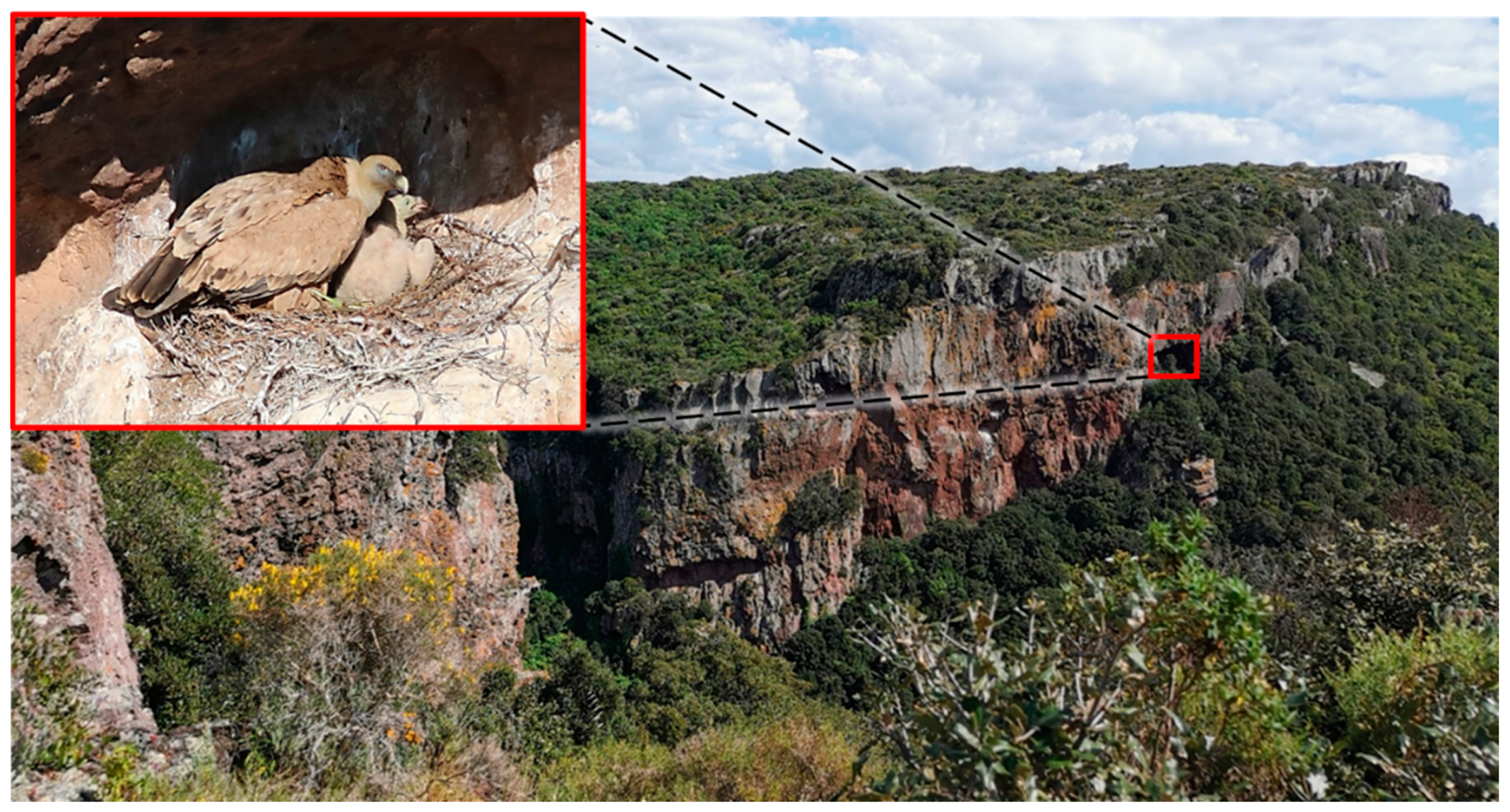
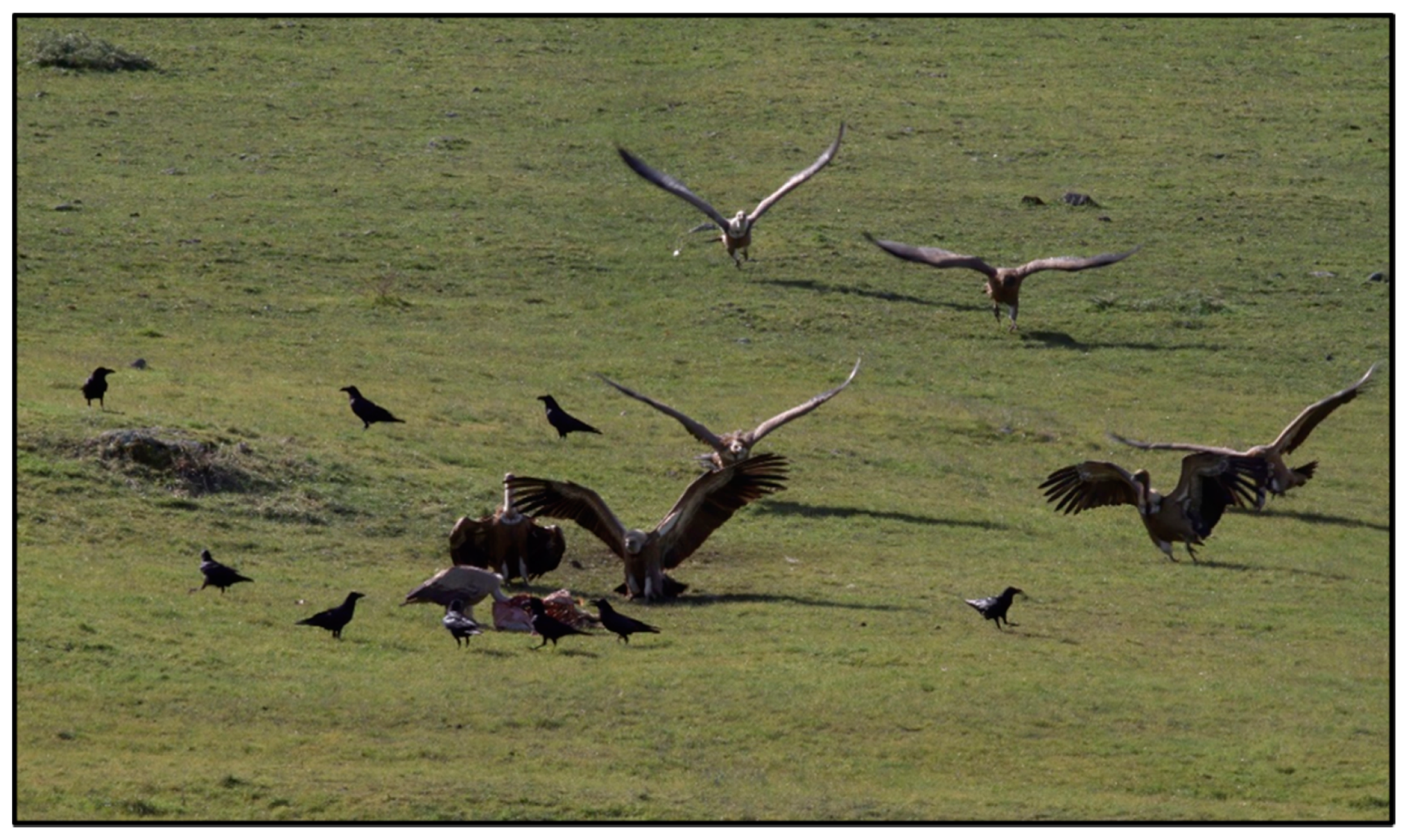
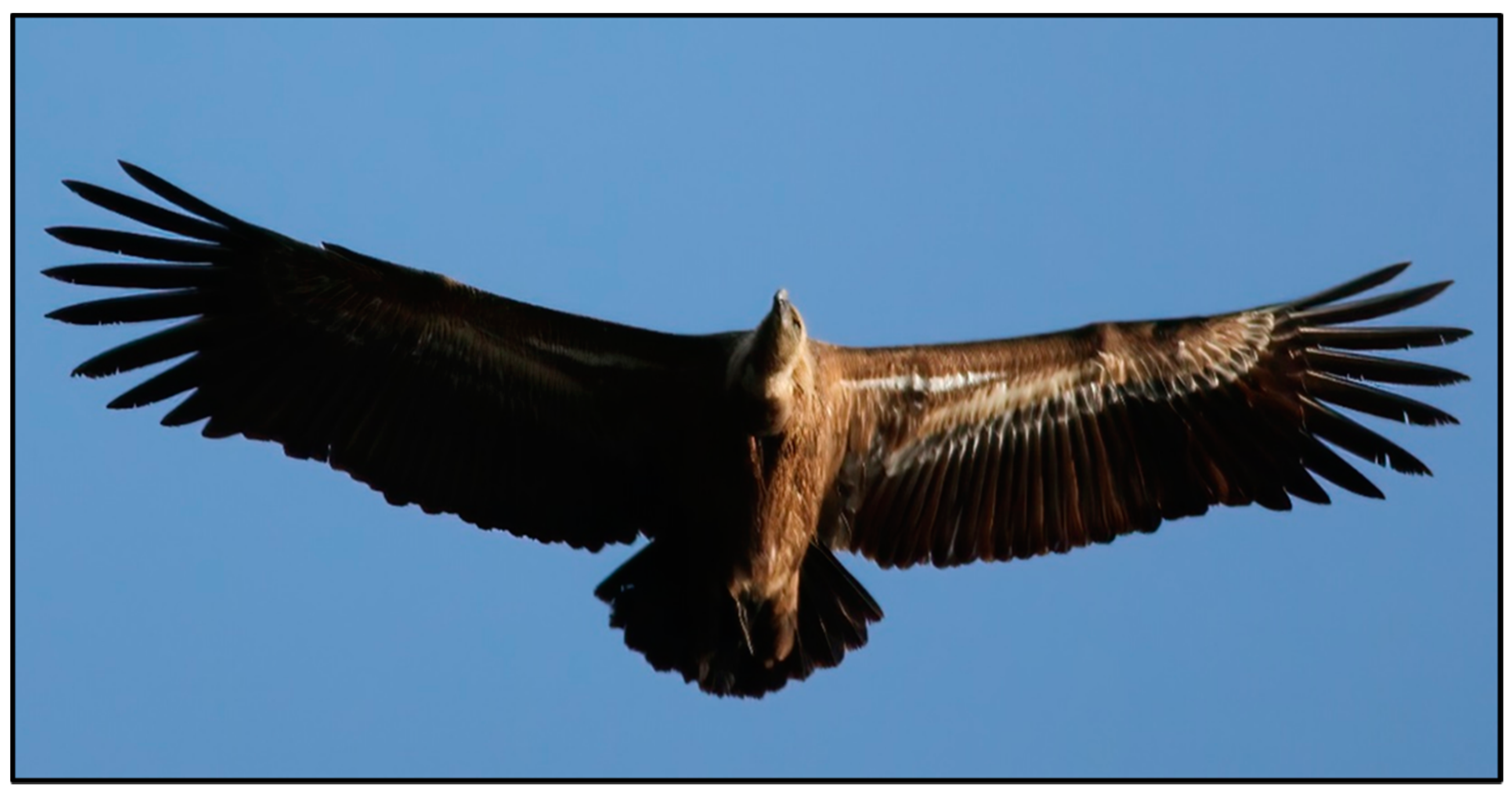
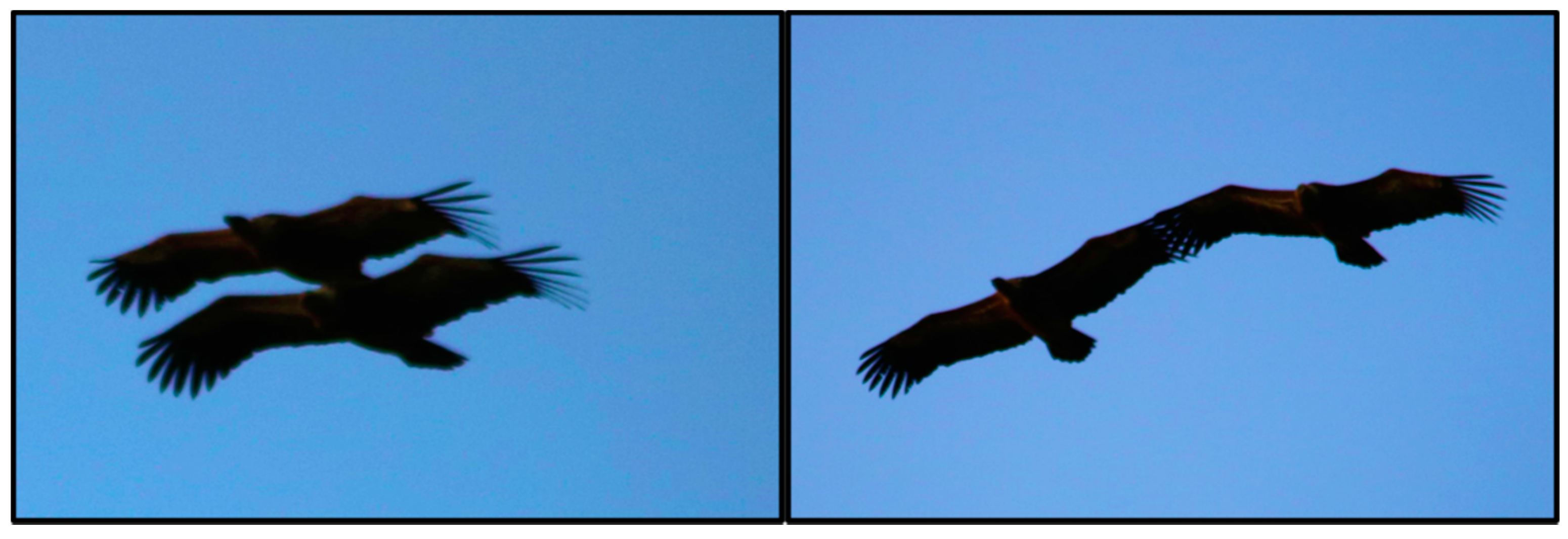
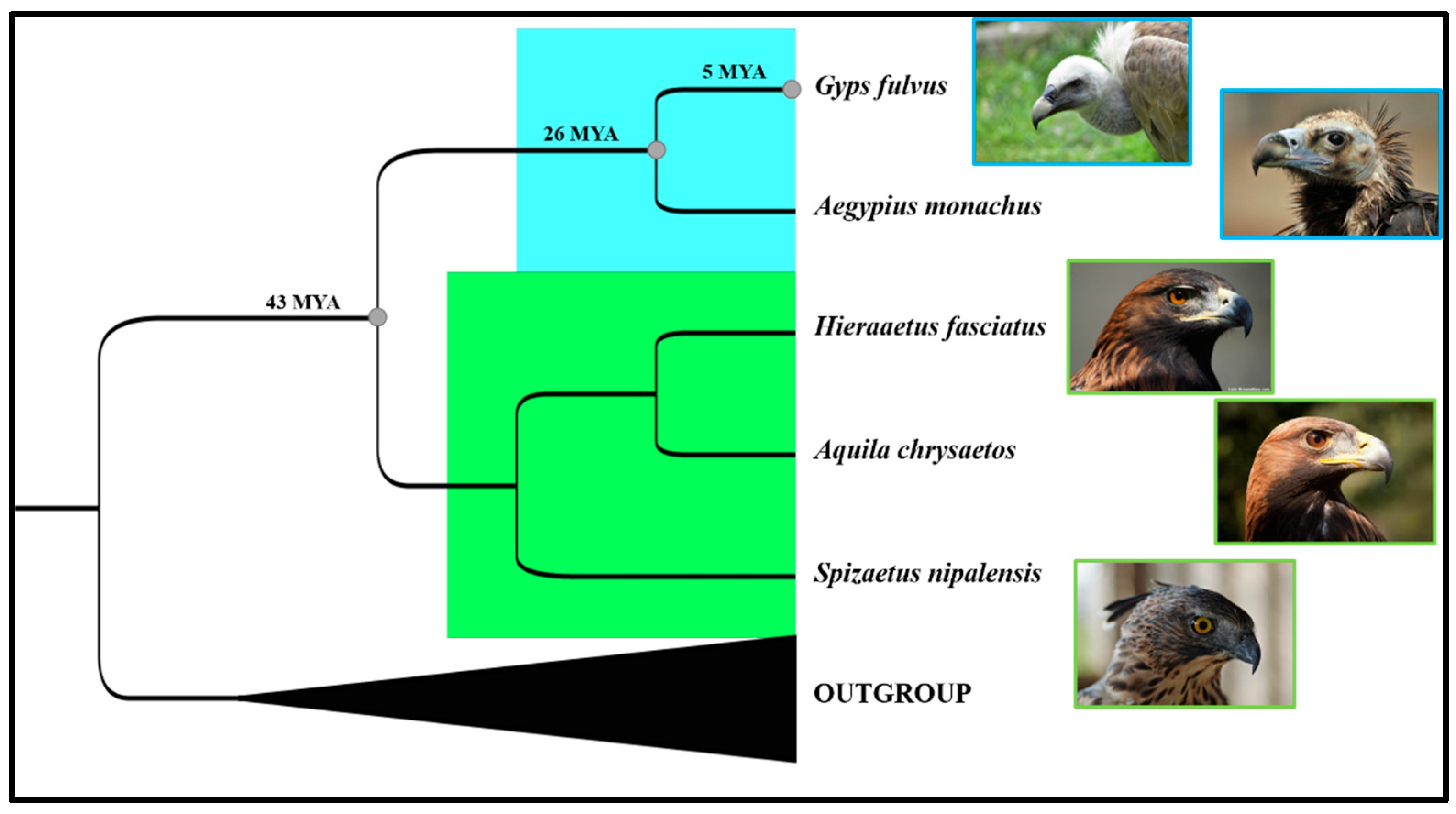
Publisher’s Note: MDPI stays neutral with regard to jurisdictional claims in published maps and institutional affiliations. |
© 2021 by the authors. Licensee MDPI, Basel, Switzerland. This article is an open access article distributed under the terms and conditions of the Creative Commons Attribution (CC BY) license (https://creativecommons.org/licenses/by/4.0/).
Share and Cite
Pirastru, M.; Mereu, P.; Manca, L.; Bebbere, D.; Naitana, S.; Leoni, G.G. Anthropogenic Drivers Leading to Population Decline and Genetic Preservation of the Eurasian Griffon Vulture (Gyps fulvus). Life 2021, 11, 1038. https://doi.org/10.3390/life11101038
Pirastru M, Mereu P, Manca L, Bebbere D, Naitana S, Leoni GG. Anthropogenic Drivers Leading to Population Decline and Genetic Preservation of the Eurasian Griffon Vulture (Gyps fulvus). Life. 2021; 11(10):1038. https://doi.org/10.3390/life11101038
Chicago/Turabian StylePirastru, Monica, Paolo Mereu, Laura Manca, Daniela Bebbere, Salvatore Naitana, and Giovanni G. Leoni. 2021. "Anthropogenic Drivers Leading to Population Decline and Genetic Preservation of the Eurasian Griffon Vulture (Gyps fulvus)" Life 11, no. 10: 1038. https://doi.org/10.3390/life11101038
APA StylePirastru, M., Mereu, P., Manca, L., Bebbere, D., Naitana, S., & Leoni, G. G. (2021). Anthropogenic Drivers Leading to Population Decline and Genetic Preservation of the Eurasian Griffon Vulture (Gyps fulvus). Life, 11(10), 1038. https://doi.org/10.3390/life11101038







